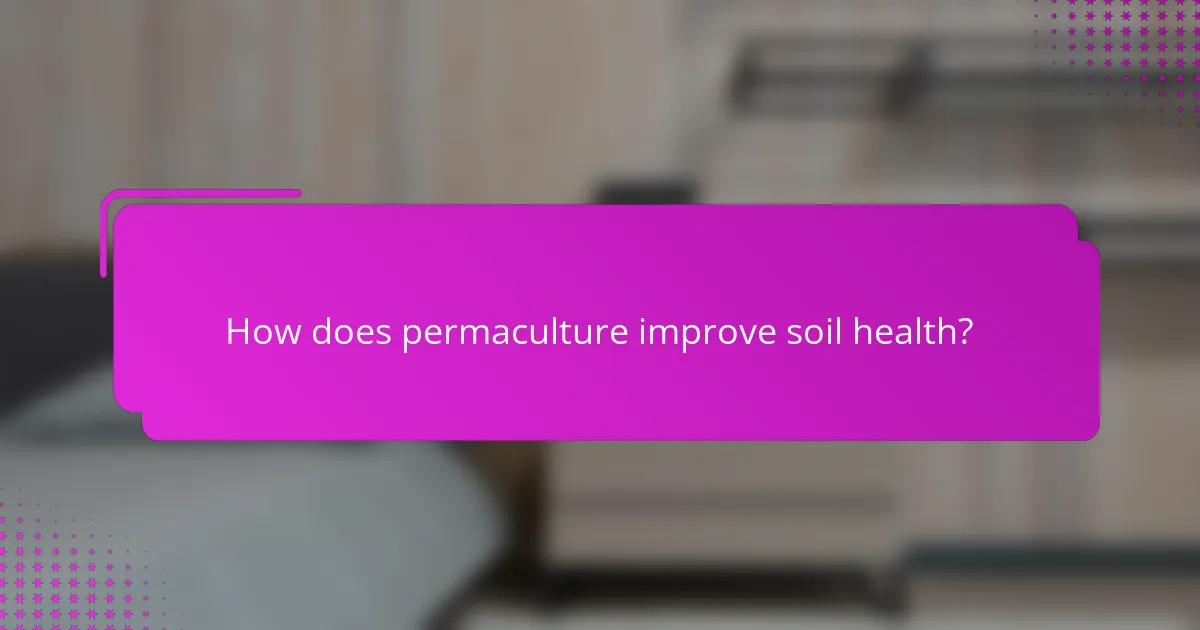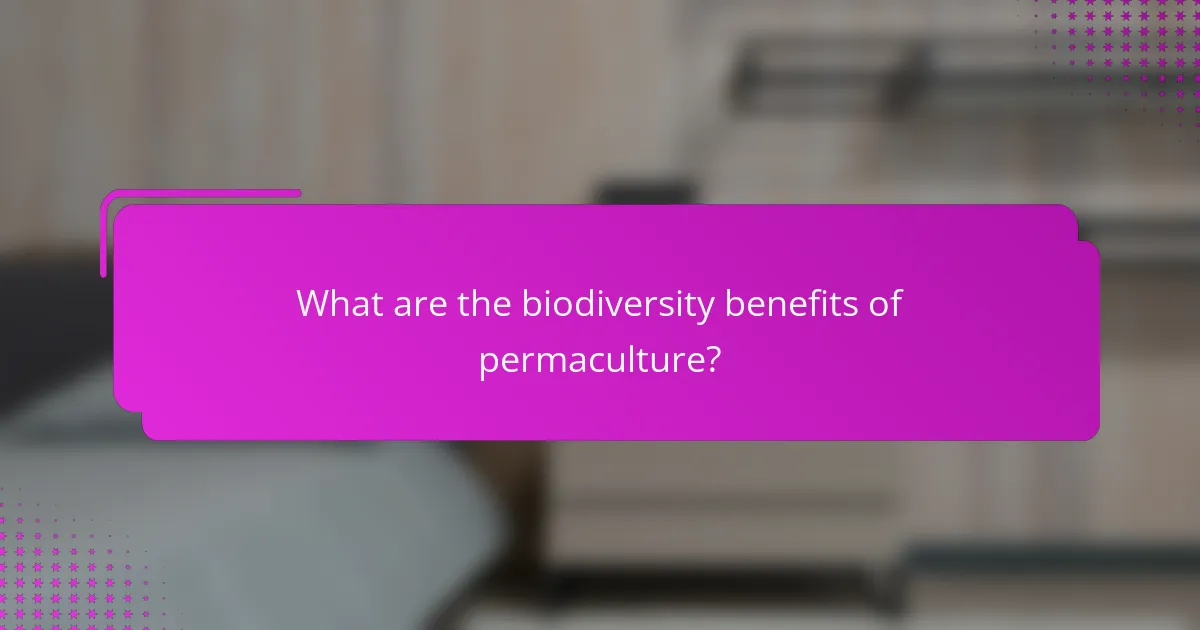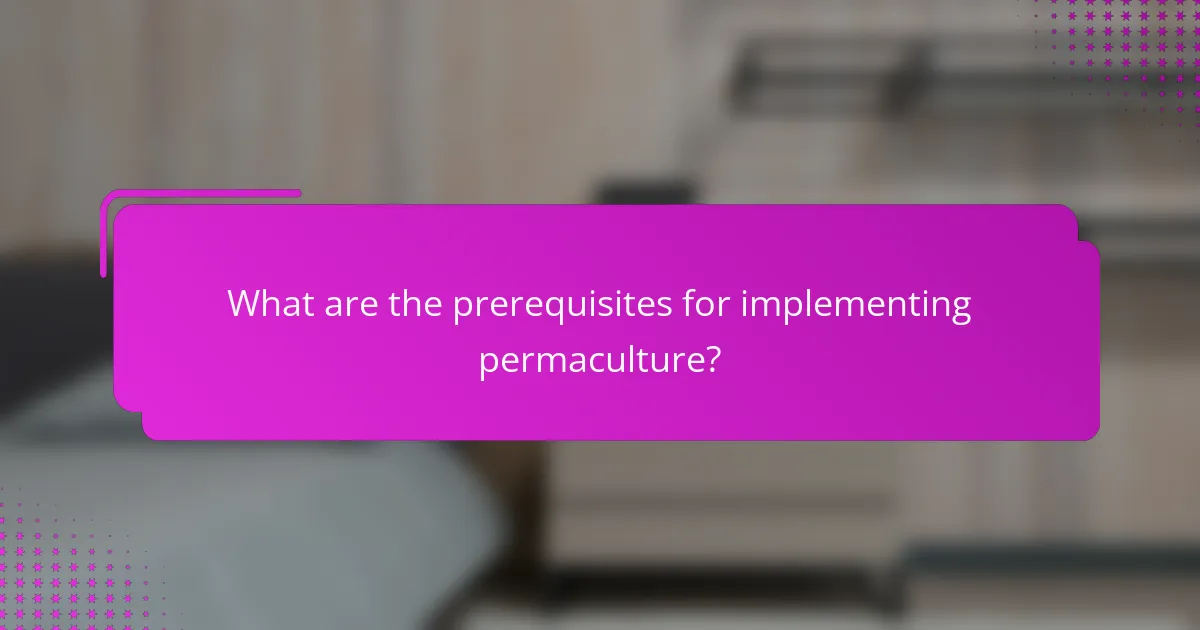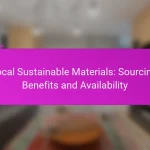Permaculture offers numerous benefits, particularly in enhancing soil health, promoting biodiversity, and improving resource efficiency. By fostering a balanced ecosystem, it creates nutrient-rich soil and supports a diverse range of species, leading to increased resilience against environmental challenges. Additionally, permaculture designs agricultural systems that leverage natural processes to minimize waste and optimize resource use, contributing to sustainable practices.

How does permaculture improve soil health?
Permaculture enhances soil health by fostering a balanced ecosystem that supports nutrient-rich soil, promotes biodiversity, and increases resilience against environmental stressors. This holistic approach integrates various practices that work together to improve the overall quality and functionality of the soil.
Enhances soil structure
Permaculture practices, such as crop rotation and cover cropping, help to improve soil structure by creating a network of roots that bind soil particles together. This leads to better aeration and drainage, which are crucial for plant health. A well-structured soil can hold nutrients more effectively, benefiting crops over time.
Incorporating organic materials like compost or mulch can further enhance soil structure, making it more crumbly and less compacted. This allows for easier root penetration and improved access to water and nutrients.
Increases organic matter
Increasing organic matter is a fundamental aspect of permaculture that significantly boosts soil health. Organic matter, derived from decomposed plants and animals, enriches the soil with nutrients and improves its ability to retain moisture. Aiming for at least 3-5% organic matter is a good target for healthy soil.
Practices such as adding compost, using green manures, and practicing no-till farming can effectively increase organic matter levels. These methods not only enhance soil fertility but also support a diverse range of soil organisms.
Promotes beneficial microorganisms
Permaculture encourages the growth of beneficial microorganisms, which play a vital role in nutrient cycling and soil health. These microorganisms break down organic matter, making nutrients available to plants and helping to suppress soil-borne diseases. A diverse microbial community can improve soil resilience and productivity.
To promote beneficial microorganisms, avoid synthetic fertilizers and pesticides, as these can disrupt microbial populations. Instead, focus on organic amendments and practices that foster a healthy soil ecosystem.
Reduces erosion
Permaculture techniques significantly reduce soil erosion by promoting ground cover and maintaining soil integrity. Practices such as planting cover crops, using contour farming, and establishing swales help to hold soil in place and prevent runoff. This is especially important in areas prone to heavy rainfall.
Maintaining a living cover on the soil not only protects it from erosion but also enhances its fertility over time. Implementing these strategies can lead to a more sustainable and productive agricultural system.
Improves water retention
Improving water retention is a key benefit of permaculture, which is essential for sustainable agriculture. Healthy soil with high organic matter content can retain moisture more effectively, reducing the need for frequent irrigation. This is particularly beneficial in regions with variable rainfall patterns.
Techniques such as mulching, creating rain gardens, and using deep-rooted plants can enhance water retention. These practices help to create a more resilient landscape that can withstand drought conditions and support plant growth during dry spells.

What are the biodiversity benefits of permaculture?
Permaculture enhances biodiversity by creating ecosystems that support a wide variety of plant and animal species. This approach fosters a balanced environment, which can lead to improved soil health and increased resilience against pests and diseases.
Supports diverse plant species
Permaculture promotes the cultivation of a variety of plant species, which can lead to more robust ecosystems. By planting companion crops and using polycultures, gardeners can create habitats that mimic natural ecosystems, allowing plants to thrive together. This diversity can improve soil structure and nutrient availability, benefiting all plants involved.
In practical terms, consider incorporating native plants alongside traditional crops. This not only supports local wildlife but also enhances the overall productivity of the garden.
Encourages wildlife habitats
Creating diverse habitats is a fundamental principle of permaculture that attracts various wildlife species. By integrating features such as ponds, hedgerows, and wildflower strips, you can provide shelter and food for birds, insects, and small mammals. This variety of habitats contributes to a balanced ecosystem.
For instance, planting a mix of flowering plants can create a rich environment for beneficial insects, which in turn support larger wildlife populations. Aim for a range of heights and types of vegetation to maximize habitat diversity.
Increases pollinator populations
Permaculture practices significantly boost pollinator populations by providing a continuous supply of food and nesting sites. By planting a variety of flowering plants that bloom at different times, you can ensure that pollinators have access to resources throughout the growing season.
To attract more pollinators, consider including plants such as lavender, sunflowers, and clover in your garden. Avoid using pesticides, as they can harm these essential species.
Enhances ecosystem resilience
Permaculture increases ecosystem resilience by fostering biodiversity, which helps systems adapt to changes and stresses. Diverse ecosystems are better equipped to handle pests, diseases, and climate fluctuations, making them more sustainable in the long run.
To enhance resilience, focus on creating a balanced mix of plants, animals, and microorganisms. Implementing practices like crop rotation and cover cropping can further strengthen the ecosystem’s ability to recover from disturbances.

How does permaculture promote resource efficiency?
Permaculture enhances resource efficiency by designing agricultural systems that use natural processes to minimize waste and maximize productivity. This approach leads to sustainable practices that conserve water, reduce chemical inputs, and optimize energy use.
Reduces water usage
Permaculture techniques, such as rainwater harvesting and swales, significantly lower water consumption. By capturing and directing rainfall, systems can maintain soil moisture without relying heavily on irrigation. This is particularly beneficial in regions facing water scarcity.
Implementing drought-resistant plants and mulching can further decrease the need for water. These methods help retain soil moisture and reduce evaporation, making gardens more resilient to dry conditions.
Minimizes chemical inputs
Permaculture promotes natural pest control and soil fertility, which minimizes the need for synthetic fertilizers and pesticides. Techniques like companion planting and crop rotation create a balanced ecosystem that naturally deters pests and enhances soil health.
By focusing on biodiversity, permaculture systems can reduce dependency on chemical inputs, leading to healthier produce and a safer environment. This approach aligns with organic farming principles, often resulting in higher market value for crops.
Maximizes energy efficiency
Energy efficiency in permaculture is achieved by designing systems that work with nature rather than against it. For example, strategically placed plants can provide shade, reducing the need for energy-intensive cooling methods.
Using renewable energy sources, such as solar panels for water heating or wind turbines for electricity, can further enhance energy efficiency. These practices not only lower operational costs but also contribute to a more sustainable energy footprint.
Utilizes local resources
Permaculture emphasizes the use of local materials and resources, which reduces transportation costs and carbon emissions. Utilizing native plants, local soil amendments, and nearby water sources fosters a self-sustaining ecosystem.
Engaging with local communities for resources, such as compost or organic waste, can also enhance soil health while minimizing waste. This collaborative approach strengthens community ties and promotes a circular economy.

What are the prerequisites for implementing permaculture?
Implementing permaculture requires a solid understanding of local conditions, including climate, soil quality, and native species. These factors are essential for creating sustainable systems that work harmoniously with the environment.
Understanding local climate
Understanding the local climate is crucial for successful permaculture design. Factors such as temperature ranges, rainfall patterns, and seasonal changes influence what plants can thrive and how water management should be approached.
For example, in temperate regions, selecting drought-resistant plants may be beneficial during dry spells, while tropical areas might require strategies for managing excess rainfall. Observing microclimates on your property can also help in optimizing plant placement.
Assessing soil quality
Assessing soil quality is a fundamental step in permaculture. Healthy soil supports diverse plant life and is rich in nutrients. Conducting a soil test can reveal pH levels, organic matter content, and nutrient deficiencies.
To improve soil health, consider practices like composting, mulching, and crop rotation. These methods can enhance soil structure and fertility, making it more productive for growing a variety of crops.
Identifying native species
Identifying native species is essential for creating a resilient permaculture system. Native plants are adapted to local conditions and often require less maintenance, making them ideal for sustainable landscaping.
Incorporating native species can enhance biodiversity, attract beneficial insects, and provide habitat for local wildlife. Research local flora and consider using resources like native plant nurseries to find suitable options for your area.

How to choose the right permaculture design for your area?
Choosing the right permaculture design for your area involves understanding local climate, soil conditions, and available resources. Tailoring your approach to these factors ensures better sustainability and productivity in your permaculture system.
Consider your local climate
Your local climate significantly influences the types of plants and animals that can thrive in your permaculture design. Assess factors such as temperature ranges, rainfall patterns, and seasonal variations. For instance, a Mediterranean climate may favor drought-resistant plants, while a temperate zone may support a wider variety of crops.
Utilizing climate data can help you select appropriate species and design elements. Resources like local agricultural extensions or climate zone maps can provide valuable insights.
Assess soil health
Soil health is crucial for a successful permaculture system. Conduct soil tests to determine pH levels, nutrient content, and organic matter. Healthy soil supports diverse plant life and improves water retention, which is essential for sustainability.
Consider implementing practices such as composting, mulching, and cover cropping to enhance soil fertility. These methods not only improve soil quality but also promote biodiversity in your ecosystem.
Evaluate available resources
Understanding the resources available in your area is vital for effective permaculture design. This includes assessing water sources, sunlight exposure, and local materials for building structures. For example, if water is scarce, consider rainwater harvesting systems or drought-resistant plants.
Additionally, take stock of local wildlife and their roles in your ecosystem. Integrating beneficial insects or animals can enhance pollination and pest control, further supporting your permaculture goals.

